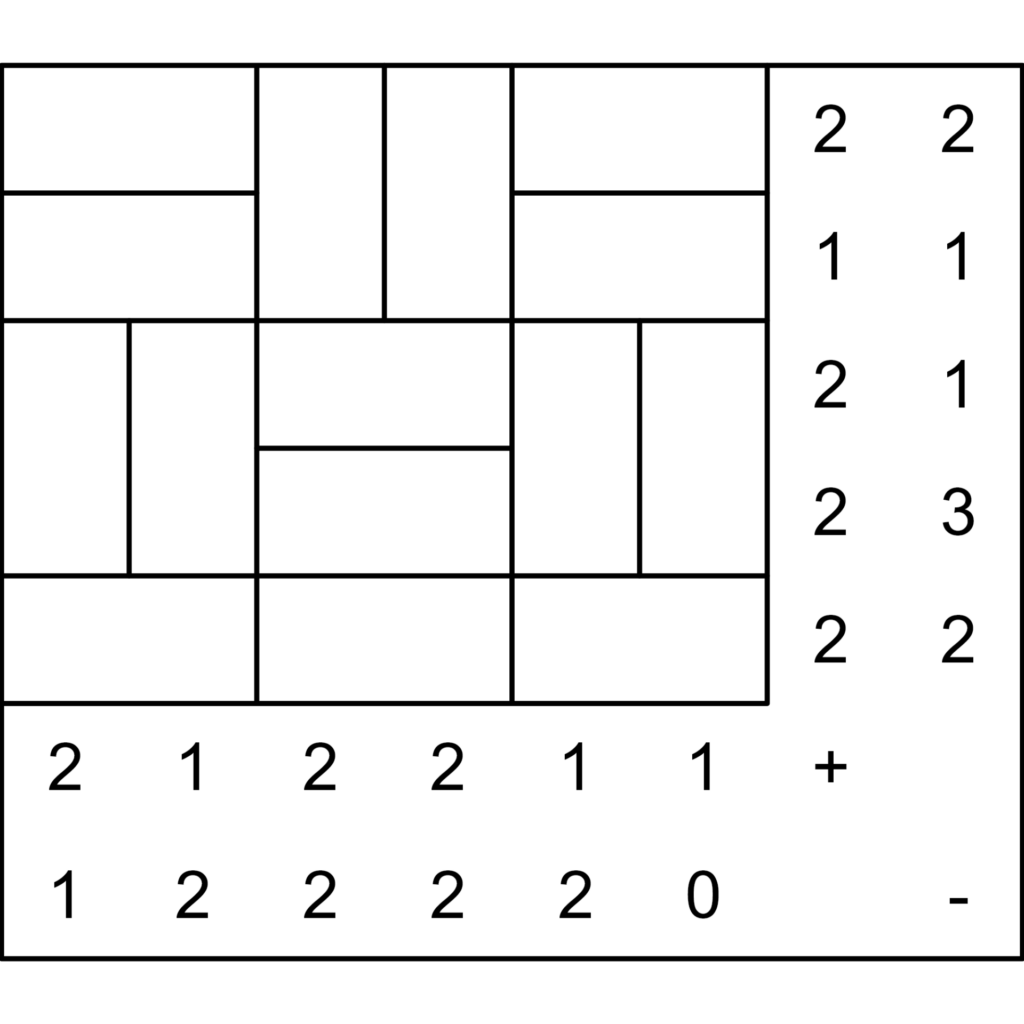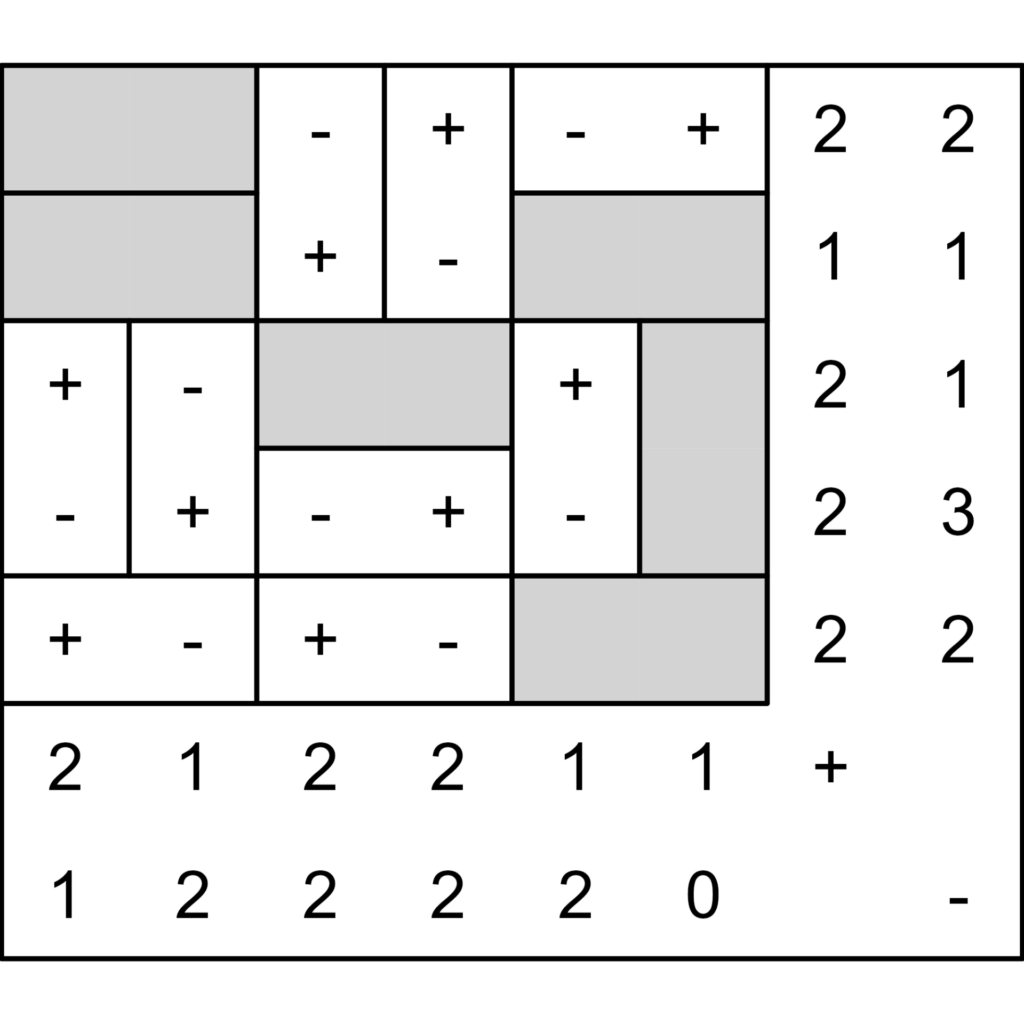Understanding Magnet Logic Puzzles
Logic puzzles are fascinating because they turn structure and reasoning into a visual game.
Magnet Logic belongs to this family—a modern puzzle concept where every piece behaves like a tiny magnet, each with two sides that must align according to simple but strict rules.
It looks simple at first glance: a rectangular grid filled with short, bar-shaped “magnets.”
Yet behind those bars lies elegant constraint logic that makes Magnet Logic puzzles engaging for both casual solvers and serious puzzle fans.


What Is a Magnet Logic Puzzle?
A Magnet Logic Puzzle consists of a rectangular grid subdivided into rectangular magnets, each magnet occupying exactly two cells—think of them as domino-shaped bars.
Each magnet has two halves:
- one half is positive (+)
- the other is negative (−)
In some puzzles, a few rectangles are neutral—they contain no magnet at all.
These neutral rectangles act like empty zones or gaps in the magnetic field.
Your goal as the solver (or as the puzzle designer’s audience) is to determine where every polarity belongs, so that the entire grid follows the magnetic rules perfectly.
The Fundamental Rules
Although visual styles may vary, the logical structure always follows these core principles:
- Each magnet has exactly one + and one − half.
No magnet can have two positives or two negatives. - Like poles cannot touch orthogonally.
Two positive halves (+ next to +) or two negative halves (− next to −) may not share an edge.
Diagonal touching is allowed. - Opposite poles may touch.
A positive next to a negative is perfectly fine—it’s what makes the puzzle interesting. - Neutral rectangles have no polarity.
They neither attract nor repel and can touch any side. - The grid must be completely filled with magnets and neutral rectangles—no gaps or overlapping regions.
- Row and column indicators (numbers placed along the outer borders) tell how many positive and negative poles appear in that row or column.
These clues are essential for deduction and ensure a single unique solution.
How a Magnet Logic Puzzle Works
Every puzzle generated by Puzzle Maker Pro – Magnet Logic includes both the puzzle layout and its single, unique solution.
The generator handles the complete logic automatically—it fills the grid with magnets, enforces the polarity constraints, and calculates the correct clue numbers at the edges.
When you publish the puzzle, the reader receives the puzzle view (blank or partially filled) and the solution view (fully completed).
That’s why you never need a separate solver module: the generator already guarantees logical consistency.
Grid Design and Even-Cell Rule
Because each magnet covers two cells, the total number of cells in the grid must always be even.
If the grid has an odd number of cells (for example, 5×5 = 25), one cell would remain unpaired and the layout could not be filled with magnets.
Valid sizes include 5×6, 6×8, 8×10, and so on.
Both height and width can be adjusted, and you can create compact educational puzzles or large, challenging grids for magazines.
Visual Anatomy of the Puzzle
In the printed or exported puzzle you’ll see three key elements:
| Element | Function | Example |
|---|---|---|
| Magnets (1×2 rectangles) | Show where each bar magnet can be placed | Dividing line through the rectangle |
| Polarity symbols | + and − (or themed equivalents) | Letters, colors, or icons |
| Neutral rectangles | Empty or shaded areas without polarity | Often shown in light grey |
Borders and Styling
- Region border: outlines each 1×2 magnet.
- Cell border: when non-zero, draws the internal dividing line between the + and − halves.
- Puzzle border: frames the entire grid for printing clarity.
These visual elements make the puzzle readable and ready for professional publication.
Row and Column Indicators
The numbers outside the grid serve as clues:
- On the right and bottom edges, you’ll see numbers like 2 1 or 3 3.
- The first number tells how many positive poles are in that line.
- The second number tells how many negative poles are in that line.
Together, these clues guide the solver to deduce polarity step by step until the entire grid fits all conditions.
Thematic Variations
While the underlying logic never changes, Magnet Logic supports several visual “skins.”
These make puzzles suitable for different audiences without altering the solving rules.
| Theme Type | Example | Typical Audience |
|---|---|---|
| Classic Polarity | + / − | Newspapers, serious puzzle sections |
| Letters | A/B or Vowel/Consonant | Language-learning worksheets |
| Colors | Red / Blue | Children’s activity pages |
| Images | Cat / Dog, Sun / Moon | Thematic puzzle books, holidays |
| Custom Pairs | Any icons or symbols | Branding or event puzzles |
Regardless of the chosen pair, each “magnet” still has two halves and must obey the same adjacency rules.
Thematically, you might say “no two dogs next to each other” instead of “no like poles adjacent,” but the logic remains identical.
Educational and Creative Applications
Teachers can use Magnet Logic to train observation, deduction, and reasoning.
Color-based or image-based themes make it accessible even for young learners.
KDP and Etsy creators can transform the same generator output into puzzle books, seasonal activity sets, or themed logic collections:
- “Cats & Dogs Logic Puzzles for Kids”
- “Polarity Challenge: 100 Magnet Logic Puzzles”
- “Vowels & Consonants Logic Workbook”
Because every puzzle exported from Puzzle Maker Pro already includes its unique solution, you can instantly compile complete puzzle-and-solution sets for publication.
Why Magnet Logic Works So Well
At its heart, the puzzle offers the right balance between structure and freedom.
- The magnets restrict placement, giving the grid a strong visual rhythm.
- The polarity rule creates an elegant interplay of adjacency logic.
- The even-cell requirement keeps every layout mathematically tidy.
- The theme flexibility makes it timeless—from educational worksheets to polished puzzle books.
It’s a perfect blend of clarity and creativity, both for solvers and for the creators who design them.
Summary
| Concept | Description |
|---|---|
| Mechanism | Grid filled with 1×2 magnets (+/−) and optional neutrals |
| Goal | Assign polarity to each magnet while following adjacency and clue rules |
| Rules | One + and − per magnet, no like poles adjacent, neutral rectangles optional |
| Grid Constraint | Even total number of cells |
| Output | Puzzle + unique solution automatically generated |
| Themes | Classic, letters, numbers, colors, or images |
| Use Cases | Education, KDP, Etsy, magazines, branded puzzle sets |
